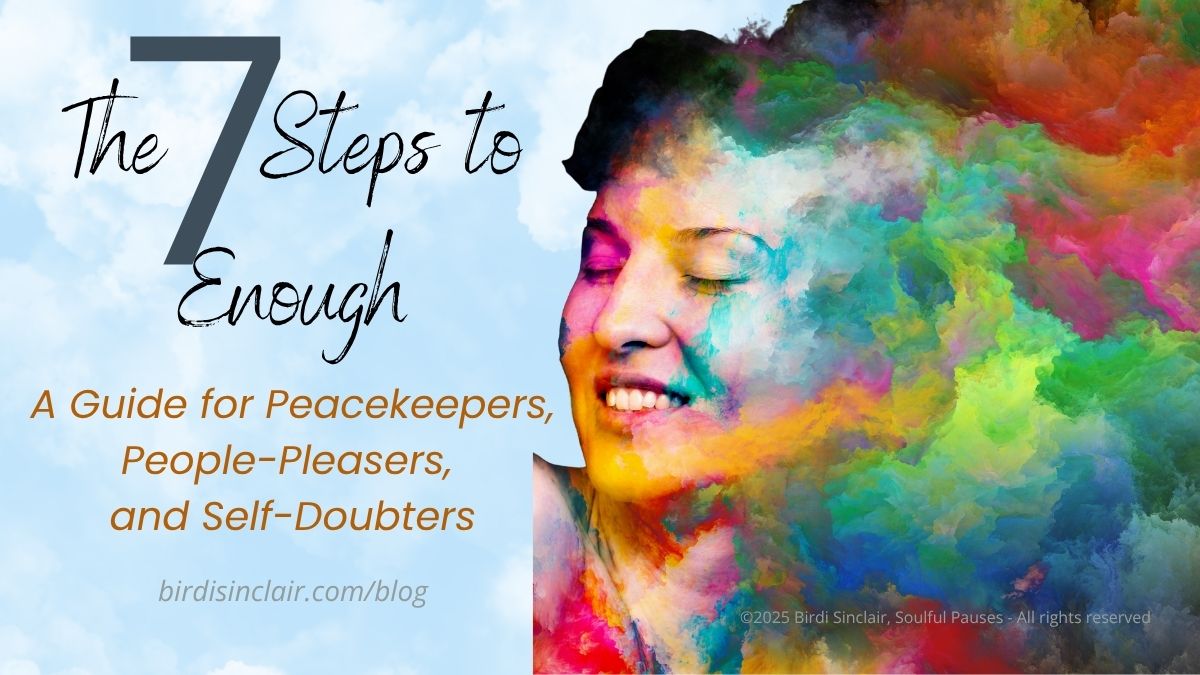
Soulful Pauses Blog
It's about connection.
The art of living whole, connected, healed, inspired.
BirdiSinclair.com/blog
The 7 Steps to Enough: A Guide for Peacekeepers, People-Pleasers, and Self-Doubters

The 7 steps to enough: gentle guidance to stop people-pleasing, overcome self-doubt, build self-trust, and embrace your worth.
The 7 Steps to Being Enough: A Guide for Peacekeepers, People-Pleasers, and Self-Doubters
The Question Beneath It All
How do you know if you’re enough? If you often bend over backwards to avoid conflict, worry about what others think, walk on eggs to be more accepted, or say yes when you want to say no, this guide is for you. If you’ve wrestled with people-pleasing or chronic self-doubt, know that you aren’t alone - and none of these habits make you "weak" or any less worthy.

Step 1: Validate the Struggle
People-pleasing and self-doubt often begin as survival skills—a genuine desire to keep the peace, make others happy, and stay connected. Maybe you learned early on that things went more smoothly if you suppressed your opinions or made yourself helpful. These instincts show a profound caring, not weakness.
Real-Life Examples:
The friend who always asks, “Where do you want to go?” but never names their own preference.
An employee who never says no, even when burnout is looming, personal life adjustments are needed, and later feels overwhelmed and resentful.
Editing messages again and again, hoping to avoid any hint of disapproval.
Agreeing to things just to avoid disappointing someone or side-stepping perceived conflict.
If you see yourself in these choices, you’re not alone. Millions manage their world by smoothing things over and questioning their value if they aren’t meeting expectations.

Step 2: Recognize the Hidden Costs
While these patterns may protect you in the short term, they come at a high cost. Naming the cost is relieving, opening a space for rest, more self-kindness and options:
Emotional Exhaustion: Monitoring others’ reactions, replaying conversations, and worrying if you did enough creates anxiety and mental fatigue.
Loss of Intimacy: Keeping the peace by hiding your thoughts or needs denies others the chance to know the real you and for you to find true connect points.
Disconnection from Yourself: Years of putting others first can blur your preferences and desires, making them seem unimportant or “selfish.”
Internal Conflict: Feeling torn between wanting to belong and being true to yourself can lead to resentment and self-betrayal.
Anxiety and Comparison: Constantly “reading the room” or comparing yourself to others fuels anxiety and the feeling of never measuring up.

Step 3: Accept Why It’s Normal
So many of us and our inner beliefs are shaped by family rules and cultural stories that equate approval with love or harmony with safety.
Social Conditioning: “Be nice,” “Don’t rock the boat,” and “Good children don’t argue” teach us to equate agreement with worth.
Early Experiences: If disagreement led to conflict or withdrawal of affection, you may have learned to keep quiet to stay safe.
Cultural Pressures: Some work and family systems value harmony so much that expressing needs or differing opinions feels unsafe.
Psychology: People-pleasing can be an adaptive strategy for those who lived through instability, criticism, or conditional affection.
You Are Not Broken. These are normal, human responses to surviving in your environment.

Step 4: Take Small, Gentle Steps
Each moment we recognize what we are experiencing within ourselves and meet it with kindness and curiosity, we open up choices within ourselves to meet the needs of the moment, and break autopilot. We learn to live from a place of love, not fear.
Practical Exercises:
Simple Check-Ins: Set a daily reminder and ask, “Am I honoring my wants or needs right now?”
Name Your Feelings: Try, “This is anxiety,” or “This is the urge to be liked.” Naming feelings helps you see them as information, not identity.
Practice Speaking Up: Write or say a “safe yes” and a “true no” (even privately) to get comfortable honoring your feelings.
Mini Scenario: You’re invited out but feel exhausted. Instead of automatically saying yes, pause and ask, “If I believed I’m enough, how would I respond?”
Reach Out for Support: Tell a trusted friend, “I’m working on speaking up for myself, and it feels awkward, but I want to try.”

Step 5: Normalize the Journey
Growth is never a straight path. It's full of surprises, body changes, experiences. While some core values may remain through our lives, they show up and interact with our constant evolving as we have experiences that we interpret and integrate.
Relapsing into Old Habits: Expect to slip back sometimes into people-pleasing or self-doubt. This is human, not failure. Leave room to notice - but now add self-kindness and curiosity. What do I actually need in this situation?
Celebrate Courage: Each time you voice a truth, say no, or even notice your feelings, you’re making progress to allowing your true self to be present.
Stories of Setbacks:
“I tried to speak up for myself at work but froze. I felt upset, but then realized the old urge to smile, not rock the boat, and accept is strong - and that’s okay. I tried again the next day, a little bolder.”Compassionate Self-Talk:
“It’s new and uncomfortable to put myself first, but I’m learning. My worth isn’t determined by perfect progress.” Putting yourself first is not a selfish disregard for others. It's giving space to be part of the whole picture, not less.

Step 6: Understand Fear and Embrace True Connection
Fear of disapproval or conflict often runs deep. Notice where and how this feels in your body. Ask how old it is and what it needs. Can you provide this for yourself? This is a way of living and opening choices for yourself from love instead of fear. Fear will always exist. It's a biological necessity. Allow self-love to join the conversation.
Where Fear Begins: Early experiences of being shut down, criticized, or ignored can make self-expression feel dangerous.
- How Fear Looks:
Nervous before asking for what you want
Second-guessing your feelings
Worry others will leave if you reveal your “real self”
Measuring your value by outcomes
Rationalizing your crummy self-talk with "proof" of your crumminess
Healing Through Connection: Over time, honest moments with others - being seen and valued for who you are - can rewrite old stories about belonging and heal your connection with yourself as an individual who also matters. You learn how to feel safe, even when things feel off, crummy, uncertain.

Step 7: Practice Self-Compassion
Self-compassion is a muscle you grow through gentle, intentional acts. It actually rewires the brain, soothes the nervous system, and also brings you in alignment with your values. All very empowering and calming, and becomes more normal to keep part of the conversation when challenges come your way.
Mindfulness Exercise:
Sit quietly and notice your breath. Place a hand on your heart.
On each exhale, tell yourself: “It’s okay to be me. I am enough.”
Affirmations: (examples - create statements that are believable to you, with examples from your lived experience - that's the only way affirmations work)
“It’s safe for me to have needs.”
“My value isn’t determined by others’ approval.”
“I can offer myself the care I give others.”
Reflection Questions:
“What’s one small thing I can do to honor myself today?”
“How does it feel to express one honest truth, just to myself?”
“In what ways have I already grown, even a little?”

Remember: Returning to Your Enough-ness
You are enough - not because you always please others, say the right thing, erase your needs, or follow the "rules" - but because you exist. With each pause and each gentle, honest step forward, you strengthen self-trust and create a more aware connection with yourself and others.
Progress is messy, healing is non-linear, and you don’t have to do it alone.
If you’re struggling with people-pleasing or chronic self-doubt, let this remind you:
You are enough - right now, just as you are.
Reply, comment, share. I'd love to hear from you. Let's talk about what no one is talking about. If I can support you in developing your self-compassion, open curiosity, and deepen self-trust, email me and we'll talk about it.
Kindly,
Birdi
Categories: : Self Trust, Soulful Pauses
Would you like to take the quiz I made for you?
Values, Strengths, Self-care - Oh My!
It takes a few minutes and then you get your results of your primary Core Value
based on biology, psychology, sociology, spirituality.
You'll receive a free 19 page guide! Easy, fun, thought provoking.
Like What You Read?
Subscribe to Soulful Pauses Blog
New posts will come right to you! Easy Peasy.
Thank you for sharing some time with me here.
Let's stay in touch.
Kindly,


Dr. Birdi Sinclair
Your Soulful Pauses and Intimate Living Coach
Sharing Spiritual Counseling, Direction, Coaching
Grief, Clarity, and Relationship Specialist
birdisinclair.com/support

 Dr. Birdi Sinclair
Dr. Birdi Sinclair 




